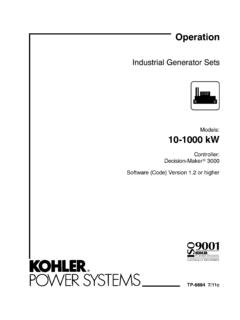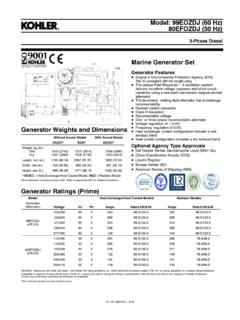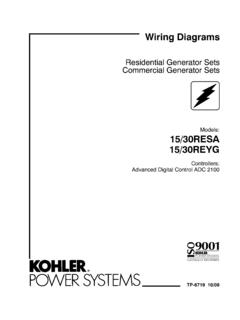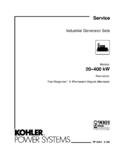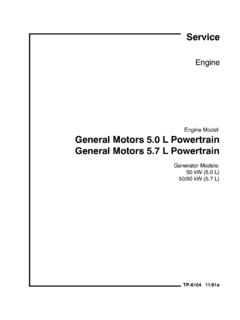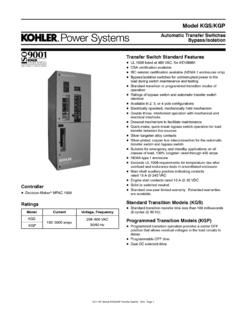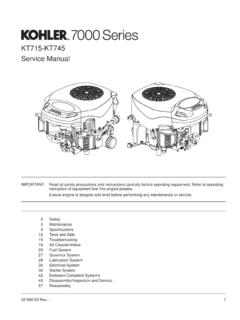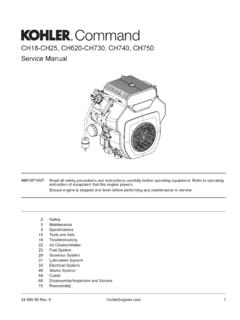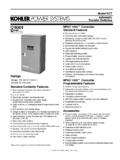Transcription of Understanding iBC Wind Load Requirements ... - …
1 2010 by kohler SYSTEMS TOPiCS 104By:Allan BliemeisterSenior Staff Engineer kohler power SystemsUnderstanding iBC wind load Requirements for Generating SystemsIt is important for standby power system enclosures to withstand loads produced by hurricanes and wind storms. These enclosures must be designed to endure the forces of wind loads that are determined by many complex factors. Standards have been created to establish common methodology for design and analysis to minimize losses due to wind events. Building standards have evolved for decades in the United States, along with codes for electrical and mechanical systems. The latest edition of building standards is embodied in the International Building Code (IBC 2000, 2003, 2006, and 2009), which sets Requirements for structures and ancillary systems, including standby power systems.
2 The purpose of this paper is to familiarize building owners and power system specifiers with the wind load compliance provisions of the IBC with respect to power system BUILDING CODE (IBC)In 2000, the International Code Council (ICC) issued its first version of the IBC. While most of the IBC deals with life-safety and fire protection of buildings and structures, it also addresses wind load design Requirements for both buildings and components attached to them. The IBC has been updated every three years and each edition references standards from a variety of sources, such as the design Requirements originally promulgated by the American Society of Civil Engineers (ASCE 7-05) in its Minimum Design Loads for Buildings and Other the IBC has an international label, currently, it only refers to building standards in the United States.
3 All states and many local authorities have adopted one version of the IBC, either the 2000, 2003, 2006 or 2009 edition. Most states have adopted the code at the state level and other local governments have adopted versions of the code at the municipal or county level. The vast majority of states have adopted the 2006 version, while fewer states have adopted the 2003 edition and several are still referencing the 2000 version. Several United States territories have adopted the 2009 version which is now available for state adoption. While the IBC is not a government mandate, its adoption has been encouraged and in some cases 2 power SYSTEMS TOPiCS 104required to ensure funding coverage by the Federal Emergency Management Administration (FEMA).
4 Generally speaking, the Requirements for wind load design are very similar regardless of which version of the code a state has adopted. The following link provides information on the IBC adoption status for each state: .The United States wind speed map provides information on basic wind speed in miles per hour in geographic zones. The first step to identifying wind load Requirements for a standby power system is to determine the installation location s basic wind rating speed. While most of the United States has a basic wind rating speed of 90 miles per hour, special regions, particularly along the Atlantic and Gulf coasts, have ratings of up to 150 miles per hour.
5 Figure 1 shows basic wind speed versus geographic regions in the United 1: IBC Basic wind Speeds Source: ASCE 7-05, figure 3 power SYSTEMS TOPiCS 104 QUALIFYING THE PRODUCTM anufacturers have three options to qualify their product: wind tunnel testing, analytical calculation, or a combination of both. wind tunnel testing is often not practical due to size and wind speed constraints. Even a small standby power set, such as 20 KW, would be too large for the vast majority of wind tunnels. Also, huge power Requirements for blower fans and massive tunnel size make testing of larger sets virtually wind tunnel testing is not practical, qualification is done most often using the analytical method.
6 Using the IBC 2009 version and applying the proper conditions, analysis can be done to qualify sets for 2000, 2003 and 2006 versions simultaneously. Specifically, the IBC 2006 and 2009 versions specify application of methods in ASCE 7-05 section These methods are detailed and DETERMINE wind LOADSA nalytical calculation uses formulas identified in the ASCE 7-05, Minimum Design Codes for Buildings and Other Structures, an industry-wide standard. The first step is to calculate the wind velocity pressure at the structure which is dependent on geography, local terrain, topography, the direction factor and the occupancy of the structure.
7 In plain language the analysis begins with anticipated wind speed and converts that to the wind pressure. The challenge is to take the complex set of many variables for each installation and simplify it to an equation with standard parameters. Per section of ASCE 7-05, wind velocity pressure at the structure is defined as:qz = .00256 KzKztKdV2Ip (lb/ft2) (ASCE 7-05 equation 6-15)The five critical parameters used to establish the wind load are: V The basic wind speed is defined at 33 feet above ground level and dependent on the geographic location. See figure 1. Kz The exposure factor is dependant on installation height above ground and local terrain.
8 As the building installation elevation increases, so does the wind speed; hence an amplification factor as installation height increases. This factor is as high as for top of building installations. Kzt The topographic factor is dependent on the gross terrain. As wind speed increases with elevation of a building, so to, wind speed increases with height up a hill. For flat terrain, this value is approximately Conversely, the factor can approach 3 on a hill due to increasing wind speed with elevation. Kzt ranges from 1 to approximately The direction factor ranges from to It is dependent on the type and portion of the structure.
9 For rectangular structures, which include generator set enclosures, the value is . The importance factor is used to reduce or amplify the basic wind speed; it is dependant on the occupancy factor of the structure. This ranges from .77 for uninhabited buildings to as high as for buildings of critical importance such as hospitals, fire stations and the 4 power SYSTEMS TOPiCS 104 Once the wind velocity pressure has been determined, it is applied with adjustment factors per the standard, to the sides and roof of the structure. The windward side receives a positive pressure, while the remaining walls and roof receive a negative pressure.
10 Negative pressure attempts to suck the sides off the building, while positive pressure tends to compress the building. The combination of internal and external pressures establishes the actual wind design pressures used for analysis on respective walls and roof. The combined pressures are defined by the following formula also part of ASCE 7-05, section :P=qGCp-qi(GCpi) (lb/ft2) (ASCE 7-05 equation 6-17)qz wind velocity pressure as calculated The gust effect factor and as applied to generator set enclosures, is by definition of ASCE 7-05, section Cp The external pressure coefficient which is dependent upon the specific geometry and proportion of the enclosure and is determined by comparison to predefined geometric proportions relative to charted Cp values in figure of the ASCE 7-05.


